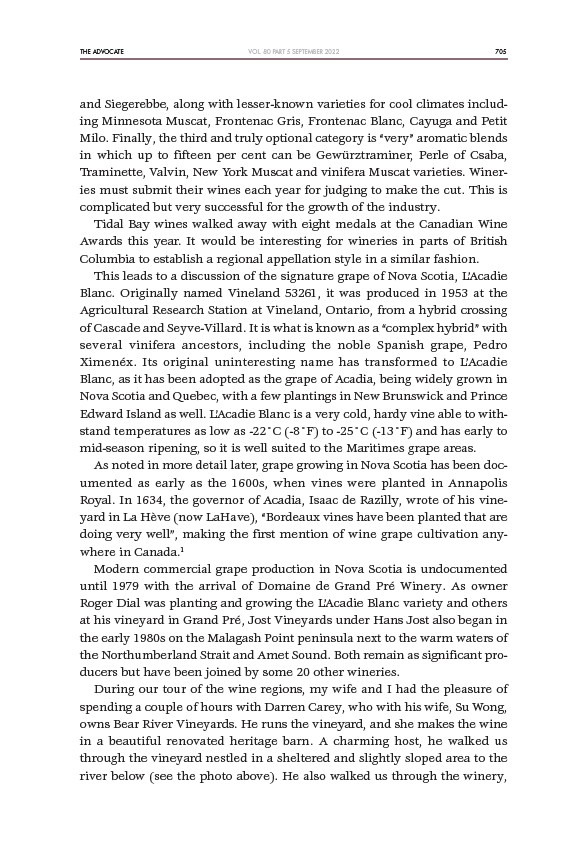
THE ADVOCATE 705
VOL. 80 PART 5 SEPTEMBER 2022
and Siegerebbe, along with lesser-known varieties for cool climates including
Minnesota Muscat, Frontenac Gris, Frontenac Blanc, Cayuga and Petit
Milo. Finally, the third and truly optional category is “very” aromatic blends
in which up to fifteen per cent can be Gewürztraminer, Perle of Csaba,
Traminette, Valvin, New York Muscat and vinifera Muscat varieties. Wineries
must submit their wines each year for judging to make the cut. This is
complicated but very successful for the growth of the industry.
Tidal Bay wines walked away with eight medals at the Canadian Wine
Awards this year. It would be interesting for wineries in parts of British
Columbia to establish a regional appellation style in a similar fashion.
This leads to a discussion of the signature grape of Nova Scotia, L’Acadie
Blanc. Originally named Vineland 53261, it was produced in 1953 at the
Agricultural Research Station at Vineland, Ontario, from a hybrid crossing
of Cascade and Seyve-Villard. It is what is known as a “complex hybrid” with
several vinifera ancestors, including the noble Spanish grape, Pedro
Ximenéx. Its original uninteresting name has transformed to L’Acadie
Blanc, as it has been adopted as the grape of Acadia, being widely grown in
Nova Scotia and Quebec, with a few plantings in New Brunswick and Prince
Edward Island as well. L’Acadie Blanc is a very cold, hardy vine able to withstand
temperatures as low as -22°C (-8°F) to -25°C (-13°F) and has early to
mid-season ripening, so it is well suited to the Maritimes grape areas.
As noted in more detail later, grape growing in Nova Scotia has been documented
as early as the 1600s, when vines were planted in Annapolis
Royal. In 1634, the governor of Acadia, Isaac de Razilly, wrote of his vineyard
in La Hève (now LaHave), “Bordeaux vines have been planted that are
doing very well”, making the first mention of wine grape cultivation anywhere
in Canada.1
Modern commercial grape production in Nova Scotia is undocumented
until 1979 with the arrival of Domaine de Grand Pré Winery. As owner
Roger Dial was planting and growing the L’Acadie Blanc variety and others
at his vineyard in Grand Pré, Jost Vineyards under Hans Jost also began in
the early 1980s on the Malagash Point peninsula next to the warm waters of
the Northumberland Strait and Amet Sound. Both remain as significant producers
but have been joined by some 20 other wineries.
During our tour of the wine regions, my wife and I had the pleasure of
spending a couple of hours with Darren Carey, who with his wife, Su Wong,
owns Bear River Vineyards. He runs the vineyard, and she makes the wine
in a beautiful renovated heritage barn. A charming host, he walked us
through the vineyard nestled in a sheltered and slightly sloped area to the
river below (see the photo above). He also walked us through the winery,